TechRadar Verdict
Pros
- +
Synchronous memory chips
- +
Price per gigabyte
- +
Should prove to be reliable
Cons
- -
Low capacity limits performance
- -
Not great with incompressible data
Why you can trust TechRadar
Performance. Reliability. Affordability. All things you really want in a solid-state drive, but is it a case of never the twain shall meet?
Until now the answer was yes, but the new Intel 330 Series SSD 60GB could be the first SSD to put the full package together.
Superficially, the Intel 330 Series SSD 60GB looks like a budget makeover of the Intel 520 Series SSD, and with that come several expectations. Broadly, we're talking about lower performance, but more specifically, cheaper components.
Like the 520 Series, the Intel 330 Series SSD 60GB is another new SSD from Intel with a SandForce controller chipset. But instead of cheaper asynchronous flash memory, it gets premium synchronous chips. That's unexpected, and is a real differentiator considering asynchronous memory is pretty much standard practice on cheaper SandForce-based drives like the Corsair Force 3 and OCZ Agility 3.
Factor in Intel's reputation for great long-term reliability and you have a very attractive proposition. Time to find out if it delivers on that promise.
Flat cap
On paper, the Intel 330 Series SSD 60GB ticks all our boxes, with one exception: capacity. We're not just talking about the impact of capacity on storage and practicality - the broader problem is that the SandForce SF-2281 controller used by Intel is pretty sensitive to capacity; the smaller you go, the lower the write performance.
SandForce-based drives aren't that hot when shunting around incompressible data like music, images and videos either. Those two weaknesses add up to an unimpressive sequential write effort of 75MB/s in the AS SSD benchmark. We haven't seen a number that low for a while.
The AS SSD read test result of 369MB/s isn't spectacular, either, but peak sequential performance is just part of the story. When it comes to random access performance (which is much more reflective of most of the data traffic any SSD has to deal with) the situation looks much rosier.
It's off the pace compared to the fastest drives, but those models are also much larger and much more expensive. For £50-odd, something's got to give, and we'd rate the random access performance as tolerable given the cost.
Benchmarks
Sequential read performance
AS SSD: Meagbytes per second: Bigger is better
INTEL SSD 330 60GB: 369
INTEL SSD 520 120GB: 497
KINGSTON HYPERX 3K 120GB: 458
Sequential write performance
AS SSD: Meagbytes per second: Bigger is better
INTEL SSD 330 60GB: 75
INTEL SSD 520 120GB: 160
KINGSTON HYPERX 3K 120GB: 171
4K random write performance
AS SSD: Meagbytes per second: Bigger is better
INTEL SSD 330 60GB: 53
INTEL SSD 520 120GB: 52
KINGSTON HYPERX 3K 120GB: 51
Performance aside, it's also worth noting that the 330 Series is rated for fewer write cycles than the Intel 520 Series and comes with a three-year instead of five-year warranty. That said, Intel's rep for long-lasting drives suggests the 330 will still be a pretty robust option.
For many users though, 60GB simply won't be enough. We were also disappointed to find substandard sequential write performance thanks to a combination of low capacity and the SandForce controller.
So, Intel has a reputation for reliability and SandForce for speed; combine the two, add affordability and you have a very attractive package. The inclusion of synchronous memory is particularly impressive, and that £50 sticker puts high-performance Intel storage in reach of a very broad market.
Technology and cars. Increasingly the twain shall meet. Which is handy, because Jeremy (Twitter) is addicted to both. Long-time tech journalist, former editor of iCar magazine and incumbent car guru for T3 magazine, Jeremy reckons in-car technology is about to go thermonuclear. No, not exploding cars. That would be silly. And dangerous. But rather an explosive period of unprecedented innovation. Enjoy the ride.
